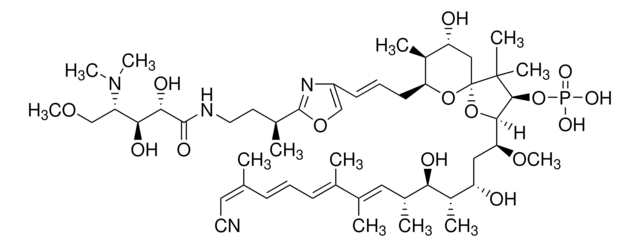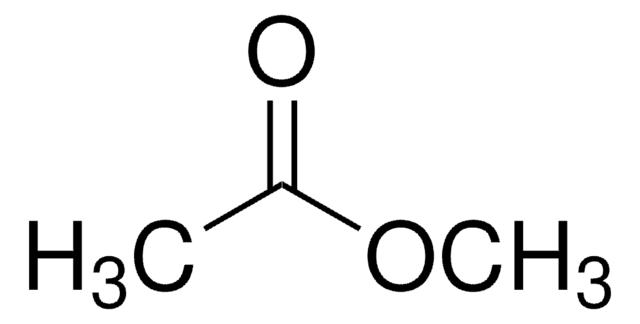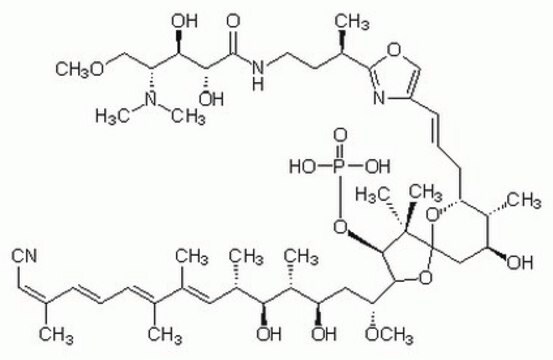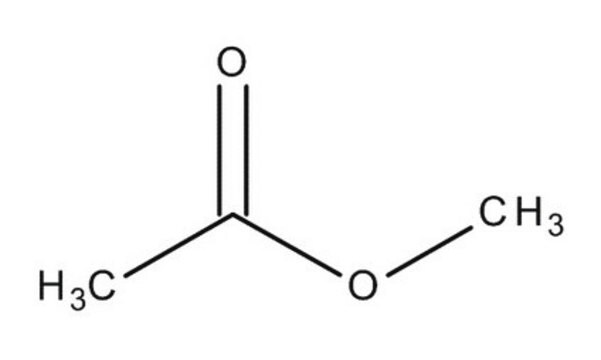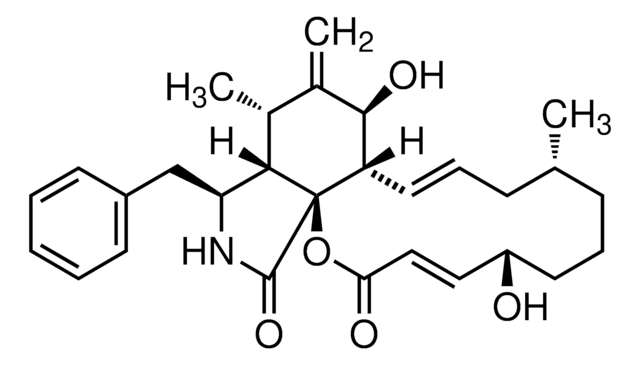45997
Methyl acetate
analytical standard
About This Item
Productos recomendados
grado
analytical standard
Nivel de calidad
densidad de vapor
2.55 (vs air)
presión de vapor
165 mmHg ( 20 °C)
Ensayo
≥99.9% (GC)
temp. de autoignición
936 °F
caducidad
limited shelf life, expiry date on the label
lim. expl.
16 %
técnicas
HPLC: suitable
gas chromatography (GC): suitable
índice de refracción
n20/D 1.361 (lit.)
n20/D 1.362
bp
57-58 °C (lit.)
mp
−98 °C (lit.)
densidad
0.934 g/mL at 25 °C
aplicaciones
cleaning products
cosmetics
environmental
flavors and fragrances
food and beverages
personal care
Formato
neat
cadena SMILES
COC(C)=O
InChI
1S/C3H6O2/c1-3(4)5-2/h1-2H3
Clave InChI
KXKVLQRXCPHEJC-UHFFFAOYSA-N
¿Está buscando productos similares? Visita Guía de comparación de productos
Descripción general
Aplicación
- Quantitative analysis of seven volatile organic compounds (VOCs) in paint coating samples by dynamic headspace-gas chromatography-mass spectrometry (D-HS-GC-MS)
- Detection of 88 VOCs in breath samples of lung cancer patients using solid-phase microextraction (SPME) combined with GC-MS
- Development of a thermal desorption-gas chromatography-mass spectrometry (TDS-GC/MS) based method for the identification of very volatile organic compounds (VVOCs) in indoor air samples
Otras notas
Palabra de señalización
Danger
Frases de peligro
Consejos de prudencia
Clasificaciones de peligro
Eye Irrit. 2 - Flam. Liq. 2 - STOT SE 3
Órganos de actuación
Central nervous system
Riesgos supl.
Código de clase de almacenamiento
3 - Flammable liquids
Clase de riesgo para el agua (WGK)
WGK 1
Punto de inflamabilidad (°F)
8.6 °F - closed cup
Punto de inflamabilidad (°C)
-13 °C - closed cup
Equipo de protección personal
Eyeshields, Faceshields, Gloves
Elija entre una de las versiones más recientes:
¿Ya tiene este producto?
Encuentre la documentación para los productos que ha comprado recientemente en la Biblioteca de documentos.
Los clientes también vieron
Artículos
Butyl methyl ether; Acetic acid; 2-Butanone; Ethyl acetate; Tetrahydrofuran; 1-Butanol; Isopropyl acetate; Heptane; Propyl acetate; 3-Methylbutanol; 4-Methyl-2-pentanone; Isobutyl acetate; Butyl acetate; Dimethyl sulfoxide; Anisole; Cumene
Protocolos
-Cymene; (−)-Menthone; α-Terpineol, natural, ≥96%, FCC, FG; Terpinolene; β-Bourbonene; 1-Octen-3-ol; β-Caryophyllene; Linalool; α-Terpinene; (−)-Menthol
Separation of Acetone; Acetic acid; Propionic acid; Ethyl butyrate; Ethanol; Isoamyl acetate; Isobutyric acid; 3-Methyl-2-butanol; Methyl acetate; 1-Propanol; Acetal, ≥98%, FG; 2-Methyl-1-pentanol; Butyl acetate; Ethyl propionate; 3-Pentanol; 2-Pentanol, 98%; Ethyl isobutyrate; Isobutyl acetate; Acetaldehyde; Furfural; Butyric acid; Methanol; Ethyl acetate
GC Analysis of Class 3 Residual Solvents on SUPELCOWAX® 10
-Cymene; 2,5-Dimethylpyrrole; Acetoin, ≥96%, FCC, FG; 2,5-Dimethylpyrazine; 2,6-Dimethylpyrazine; 2-Ethylpyrazine, ≥98%, FG; 2,3-Dimethylpyrazine; 4-Heptanone; 3-Ethylpyridine; 2,3,5-Trimethylpyrazine; Furfural; Pyrrole; Furfuryl acetate; Linalool; Linalyl acetate; 5-Methylfurfural; γ-Butyrolactone; 2-Acetyl-1-methylpyrrole; Furfuryl alcohol; 2-Acetylpyrrole; Pyrrole-2-carboxaldehyde
Nuestro equipo de científicos tiene experiencia en todas las áreas de investigación: Ciencias de la vida, Ciencia de los materiales, Síntesis química, Cromatografía, Analítica y muchas otras.
Póngase en contacto con el Servicio técnico